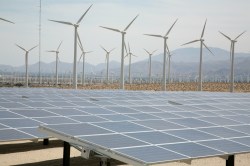
ShutterstockIt’s all good.
Solar power installations are expected to edge out new wind farms this year for the title of fastest-growing clean energy source.
Bloomberg New Energy Finance has projected that photovoltaic plants will add 36.7 gigawatts of capacity this year — up 20 percent from last year. New wind farms, meanwhile, will add 35.5 gigawatts. That’s an awesome figure, too, but it’s nearly a quarter less for wind than in 2012. From Bloomberg:
Lower panel costs and government support are accelerating deployment of solar energy even as growth slows in the mature European markets. Wind installations, more than double solar before 2011, are also being slowed by Europe, as well as a lack of clarity on policy in the U.S. and China.
Wind power installations will drop by almost a quarter this year to their lowest level since 2008 because of the policies in these two countries, according to Justin Wu, [Bloomberg New Energy Finance]’s head of wind analysis. China and the U.S. combined represented about 60 percent of the global wind market last year.
What are these policies of which they speak? The biggies are known as renewable energy “production tax credits,” and they expire at the end of every year unless Congress takes action to, well, renew them. That hasn’t happened so far this year, and with Republicans in Congress about to force a government shutdown, it doesn’t look likely. Here’s Bloomberg again:
Neither of the tax-writing committees in the House and Senate have yet to mark up a legislative package to extend the provisions, with time running short before they expire Dec. 31, energy analyst Kevin Book said.
“It’s pretty telling” that “there is still no draft, no amendment has come up for a vote” on the extension, said Book, the managing director of research for ClearView Energy Partners, a Washington-based consulting firm.
“A better than average probability” exists that the expiring tax credits will be allowed to lapse, Book said, though he predicted they would be retroactively reinstated at some point in 2014.
That’s exactly what happened this year, after Congress let the tax credit lapse at the end of 2012 only to renew it in January — and wind energy has attracted significant private funding lately. Still, for the time being, wind power is blowing in the political breezes. Solar, on the other hand, is having its day in the sun.
Correction: This post originally contained a reference and a link to an article about a California energy project. We’ve removed this passage because that project is solar thermal, not photovoltaic.



